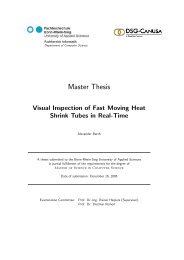Master Thesis - Hochschule Bonn-Rhein-Sieg
Master Thesis - Hochschule Bonn-Rhein-Sieg
Master Thesis - Hochschule Bonn-Rhein-Sieg
You also want an ePaper? Increase the reach of your titles
YUMPU automatically turns print PDFs into web optimized ePapers that Google loves.
6. Evaluating the safety <strong>Master</strong> <strong>Thesis</strong> Björn Ostermann page 100 of 126<br />
6 Evaluating the safety of the system<br />
The primary goal of this master thesis was a feasibility study on realizing a working collaboration<br />
workplace, a workplace where human and robot work alongside each other. This goal has been<br />
reached, as described in previous chapters.<br />
The safety of the testing environment was verified by the application of a hold to run button and the<br />
reduced speed of the robot. Realizing such a workplace in praxis would require an integration of safety<br />
with a reduced inclusion of humans into the safety concept.<br />
For the integration of safety in robot workplaces there are several regulations to be considered. Apart<br />
from formal requirements those regulations also contain requirements on safety. Considering those<br />
safety requirements is made easier by applying appropriate standards.<br />
The main point of the developed approach is to ensure the safety distance between robot and human.<br />
The safety distance required by the given workplace is evaluated, based on the performance of its<br />
components and the developed program. Afterwards the reverse is computed, taking a desired safety<br />
distance and showing the necessary performance in the components.<br />
The results are compared, showing the state of development of the system and the necessary<br />
improvements.<br />
6.1 Regulations<br />
When placing machinery on the market and/or putting it into service several regulations have to be<br />
applied. In the European Common Market requirements are laid down in directives for most products,<br />
so called harmonized products. When concentrating on the requirements of this robot working place,<br />
especially on its safety, the main European directives that have to be considered are:<br />
- Machinery Directive 98/37/EC – until 28.12.2009<br />
- Machinery Directive 2006/42/EC – from 29.12.2009<br />
- Pressure equipment Directive 97/23/EC<br />
- Low voltage Directive 2006/95/EC<br />
- EMC Directive 2004/108/EC<br />
Those directives have to be transposed into national law by the member states without changes. Thus<br />
it is possible for this project to relay on the European law, making the results of the project applicable<br />
in the whole common market.<br />
Considering the safety problems induced by the new approach on collaboration of human and robot,<br />
only the requirements of the machinery directive are important. The safety requirements of all other<br />
regulations are not relevant for this new concept. Their application causes no special problems that<br />
have not already been solved in today’s workplaces.














